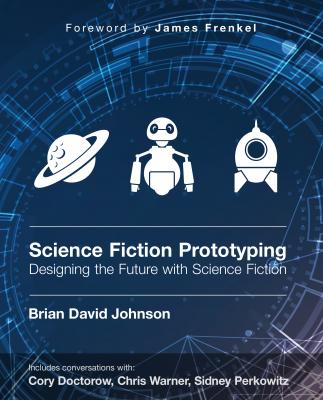ТОП просматриваемых книг сайта:
Science Fiction Prototyping. Brian David Johnson
Читать онлайн.Название Science Fiction Prototyping
Год выпуска 0
isbn 9781608456567
Автор произведения Brian David Johnson
Жанр Справочная литература: прочее
Серия Synthesis Lectures on Computer Science
Издательство Ingram
Because most science fiction takes place in the future, the backgrounds are largely products of the writers’ imaginations. The future can be researched only to a limited extent, for when it comes to saying exactly what the years ahead hold for us, even the most well-informed scientists can offer only conjecture. The SF (science fiction) writer’s vision of the future must be detailed and believable, or ultimately the reader will not believe anything about the story—not the characters, the motivation, or the plot.
The near future. Structuring a story background of near future—twenty, thirty, or forty years from now—is in some way more difficult than creating an entire alien planet in some impossibly distant age, for the near-future background cannot be wholly a product of the imagination. The writer must conduct extensive research to discover what engineer and scientists project for every aspect of future life. From that data, the author then extrapolates a possible world of tomorrow, one which might logically rise out of the base of the future which we are building today. (Koontz, 1981)
This is good news! As Koontz points out, it is important that the writer of a near-future story understands what engineers and scientists are working on and projecting for the future. In the case of science fiction prototypes, much of this is accomplished when the topic has been selected. The fictional near-future world of the story/prototype is dictated by the actual science of the topic.
Step 2: The Scientific Inflection Point
Now that you have picked your science and you have your idea, it is time to see what happens when that science (or technology or topic) is placed into your world.
When doing this, it is important to focus specifically on the people and systems in your world. The inflection point is not about the science itself (you should explore that in Step one). Step 2 is all about the effect that this new science or technology might have on the daily lives, governments and systems in your story.
Step 3: Ramifications of the Science on People
Once you have unleashed you idea into your world, it will have knock on effects. The people in your story will adapt and change because of the technology you have introduced. You have to ask yourself: has it made their lives better? Has it made their lives worse? Have they adapted to the problems or opportunities it has brought about?
This typically is where the plot of your story, movie or comic book can get really interesting. In the following three example chapters about short stories, movies and comic books, we will give you examples of how you might have the situation or plot of your SF prototype get so bad that the people in your story must take action.
This is not only good story telling but it is also beneficial to the development of the technology or science you are exploring. Pushing your plot to the extremes (either good or bad) will expose new areas for investigation or exploration in the real world. Once you have explored and mapped the outer edges and extreme scenarios, then you can map back to the middle to a more normal and realistic situation. But going to these extremes will help give clarity to your idea.
Step 4: The Human Inflection Point
The situation in your SF prototype has gotten dire. You have gone to the extreme! The characters are at their wits end. Their lives may even be in danger. Ask yourself: what do your characters need to do to survive? What are the human ramifications of the science you have selected and the situation it has brought out?
This is the point where we learn what your characters will do to either adapt themselves to the science or technology you have introduced in Step 2 or the people in your story will alter or change the science to suit themselves. Both of these outcomes need to be in keeping with the world you have created and the science needs to stay logical as well. It is important in Step 4 that the changes be believable for the virtual world and stay within the constraints of science. If you constrain yourself to these boundaries, then the outcome of your SF prototype will be more valuable and applicable to further investigation.
Конец ознакомительного фрагмента.
Текст предоставлен ООО «ЛитРес».
Прочитайте эту книгу целиком, купив полную легальную версию на ЛитРес.
Безопасно оплатить книгу можно банковской картой Visa, MasterCard, Maestro, со счета мобильного телефона, с платежного терминала, в салоне МТС или Связной, через PayPal, WebMoney, Яндекс.Деньги, QIWI Кошелек, бонусными картами или другим удобным Вам способом.

